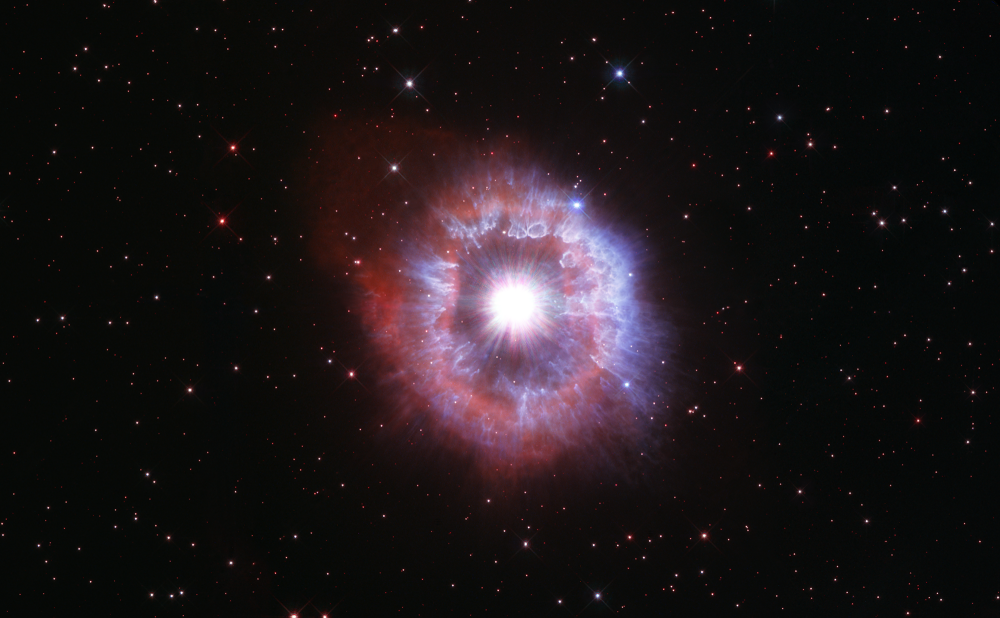900-year-old cosmic mystery surrounding Chinese supernova solved
A 900-year-old cosmic mystery surrounding the origins of a famous supernova first spotted over China in 1181AD has finally been solved.

[Sept 16, 2021: University of Manchester]
A Hubble Space Telescope image of AG Carinae, an unstable star that is on the brink of exploding. (Image credit: NASA, ESA, STScI).
A 900-year-old cosmic mystery surrounding the origins of a famous supernova first spotted over China in 1181AD has finally been solved, according to an international team of astronomers.
New research published today (September 15, 2021) says that a faint, fast expanding cloud (or nebula), called Pa30, surrounding one of the hottest stars in the Milky Way, known as Parker’s Star, fits the profile, location and age of the historic supernova.
There have only been five bright supernovae in the Milky Way in the last millennium (starting in 1006). Of these, the Chinese supernova, which is also known as the ‘Chinese Guest Star’ of 1181AD has remained a mystery. It was originally seen and documented by Chinese and Japanese astronomers in the 12th century who said it was as bright as the planet Saturn and remained visible for six months. They also recorded an approximate location in the sky of the sighting, but no confirmed remnant of the explosion has even been identified by modern astronomers. The other four supernovae are all now well known to modern day science and include the famous Crab nebula.
False-color images of Parker's star and the nebula Pa30, which scientists now believe are connected with reports of a supernova seen in 1181. (Image credit: The University of Hong Kong)
The source of this 12th century explosion remained a mystery until this latest discovery made by a team of international astronomers from Hong Kong, the UK, Spain, Hungary and France, including Professor Albert Zijlstra from The University of Manchester. In the new paper, the astronomers found that the Pa 30 nebula is expanding at an extreme velocity of more than 1,100 km per second (at this speed, traveling from the Earth to the Moon would take only 5 minutes). They use this velocity to derive an age at around 1,000 years, which would coincide with the events of 1181AD.
Prof Zijlstra (Professor in Astrophysics at the University of Manchester) explains: “The historical reports place the guest star between two Chinese constellations, Chuanshe and Huagai. Parker’s Star fits the position well. That means both the age and location fit with the events of 1181.”
Pa 30 and Parker's Star have previously been proposed as the result of a merger of two White Dwarfs. Such events are thought to lead to a rare and relatively faint type of supernova, called a ‘Type Iax supernova’.
Prof Zijlstra added: “Only around 10% of supernovae are of this type and they are not well understood. The fact that SN1181 was faint but faded very slowly fits this type. It is the only such event where we can study both the remnant nebula and the merged star, and also have a description of the explosion itself.”
The merging of remnant stars, white dwarfs and neutron stars, give rise to extreme nuclear reactions and form heavy, highly neutron-rich elements such as gold and platinum. Prof. Zijlstra said: “Combining all this information such as the age, location, event brightness and historically recorded 185-day duration, indicates that Parker’s star and Pa30 are the counterparts of SN 1181. This is the only Type Iax supernova where detailed studies of the remnant star and nebula are possible. It is nice to be able to solve both a historical and an astronomical mystery.”
Like these kind of feel good stories? Get the Brighter Side of News' newsletter.
Tags: #New_Discoveries, #Astronomy, #Space, #Nebula, #Stars, #The_Brighter_Side_of_News
Joshua Shavit
Science & Technology Writer | AI and Robotics Reporter
Joshua Shavit is a Los Angeles-based science and technology writer with a passion for exploring the breakthroughs shaping the future. As a contributor to The Brighter Side of News, he focuses on positive and transformative advancements in AI, technology, physics, engineering, robotics and space science. Joshua is currently working towards a Bachelor of Science in Business Administration at the University of California, Berkeley. He combines his academic background with a talent for storytelling, making complex scientific discoveries engaging and accessible. His work highlights the innovators behind the ideas, bringing readers closer to the people driving progress.



